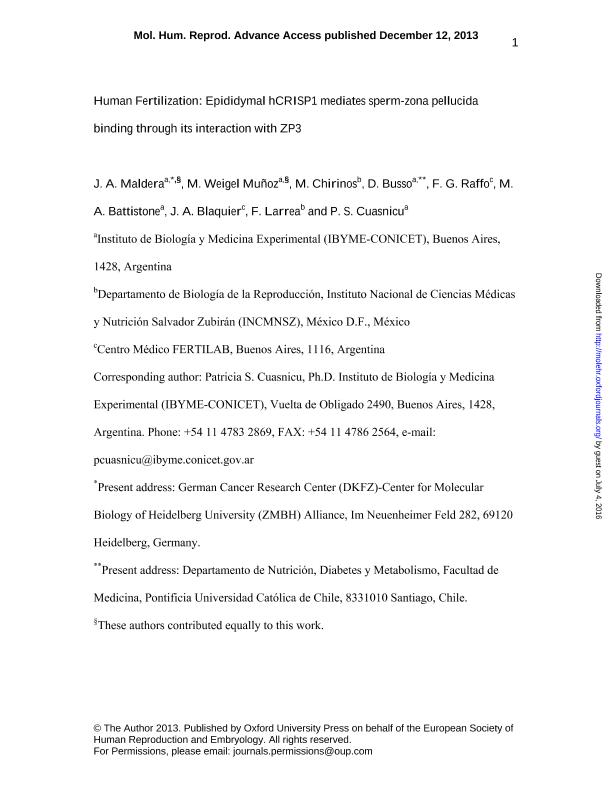Mostrar el registro sencillo del ítem
dc.contributor.author
Maldera, Julieta Antonella

dc.contributor.author
Weigel Muñoz, Mariana

dc.contributor.author
Chirinos, M.
dc.contributor.author
Busso, Dolores
dc.contributor.author
Raffo, F. G. E.
dc.contributor.author
Battistone, Maria Agustina

dc.contributor.author
Blaquier, J. A.
dc.contributor.author
Larrea, F.
dc.contributor.author
Cuasnicu, Patricia Sara

dc.date.available
2016-07-01T17:54:34Z
dc.date.issued
2014-04-01
dc.identifier.citation
Maldera, Julieta Antonella; Weigel Muñoz, Mariana; Chirinos, M.; Busso, Dolores; Raffo, F. G. E.; et al.; Human fertilization: epididymal hCRISP1 mediates sperm zona pellucida binding through its interaction with ZP3; Oxford University Press; Molecular Human Reproduction; 20; 4; 1-4-2014; 341-349
dc.identifier.issn
1360-9947
dc.identifier.uri
http://hdl.handle.net/11336/6291
dc.description.abstract
Human epididymal CRISP1 (hCRISP1) associates with sperm during maturation and participates in gamete fusion through egg complementary sites. Its homology with both rodent epididymal CRISP1 and CRISP4 reported to participate in the previous stage of sperm binding to the zona pellucida (ZP), led us to further investigate the functional role of hCRISP1 by studying its involvement in human sperm-ZP interaction. Human hemizona (HZ) were inseminated with human capacitated sperm in the presence of either anti-hCRISP1 polyclonal antibody to inhibit sperm hCRISP1, or bacterially-expressed hCRISP1 (rec-hCRISP1) to block putative hCRISP1 binding sites in the ZP. Results revealed that both anti-hCRISP1 and rec-hCRISP1 produced a significant inhibition in the number of sperm bound per HZ compared with the corresponding controls. The finding that neither anti-hCRISP1 nor rec-hCRISP1 affected capacitation-associated events (i.e. sperm motility, protein tyrosine phosphorylation or acrosome reaction) supports a specific inhibition at the sperm?egg interaction level. Moreover, immunofluorescence experiments using human ZP-intact eggs revealed the presence of complementary sites for hCRISP1 in the ZP. To identify the ligand of hCRISP1 in the ZP, human recombinant proteins ZP2, ZP3 and ZP4 expressed in insect cells were co-incubated with hCRISP1 and protein?protein interaction was analyzed by ELISA. Results revealed that rec-hCRISP1 mainly interacted with ZP3 in a dose-dependent and saturable manner, supporting the specificity of this interaction. Altogether, these results indicate that hCRISP1 is a multifunctional protein involved notonly in sperm?egg fusion but also in the previous stage of sperm?ZP binding through its specific interaction with human ZP3.
dc.format
application/pdf
dc.language.iso
eng
dc.publisher
Oxford University Press

dc.rights
info:eu-repo/semantics/openAccess
dc.rights.uri
https://creativecommons.org/licenses/by-nc-sa/2.5/ar/
dc.subject
Fertilization
dc.subject
Hcrisp1
dc.subject
Oocyte
dc.subject
Sperm
dc.subject
Zona Pellucida
dc.subject.classification
Biología Reproductiva

dc.subject.classification
Ciencias Biológicas

dc.subject.classification
CIENCIAS NATURALES Y EXACTAS

dc.title
Human fertilization: epididymal hCRISP1 mediates sperm zona pellucida binding through its interaction with ZP3
dc.type
info:eu-repo/semantics/article
dc.type
info:ar-repo/semantics/artículo
dc.type
info:eu-repo/semantics/publishedVersion
dc.date.updated
2016-06-15T19:11:17Z
dc.identifier.eissn
1460-2407
dc.journal.volume
20
dc.journal.number
4
dc.journal.pagination
341-349
dc.journal.pais
Reino Unido

dc.journal.ciudad
Oxford
dc.conicet.avisoEditorial
This is a pre-copyedited, author-produced PDF of an article accepted for publication in Mol. Hum. Reprod. following peer review. The version of record Mol. Hum. Reprod. (2014) 20 (4): 341-349. doi: 10.1093/molehr/gat092 is available online at: http://molehr.oxfordjournals.org/content/20/4/341
dc.description.fil
Fil: Maldera, Julieta Antonella. Consejo Nacional de Investigaciones Científicas y Técnicas. Instituto de Biología y Medicina Experimental (i); Argentina. Heidelberg University. Center for Molecular Biology; Alemania
dc.description.fil
Fil: Weigel Muñoz, Mariana. Consejo Nacional de Investigaciones Científicas y Técnicas. Instituto de Biología y Medicina Experimental (i); Argentina
dc.description.fil
Fil: Chirinos, M.. Instituto Nacional de Ciencias Médicas y Nutrición Salvador Zubiran; México
dc.description.fil
Fil: Busso, Dolores. Pontificia Universidad Católica de Chile; Chile. Consejo Nacional de Investigaciones Científicas y Técnicas. Instituto de Biología y Medicina Experimental (i); Argentina
dc.description.fil
Fil: Raffo, F. G. E.. Centro Médico Fertilab; Argentina
dc.description.fil
Fil: Battistone, Maria Agustina. Consejo Nacional de Investigaciones Científicas y Técnicas. Instituto de Biología y Medicina Experimental (i); Argentina
dc.description.fil
Fil: Blaquier, J. A.. Centro Médico Fertilab; Argentina
dc.description.fil
Fil: Larrea, F.. Instituto Nacional de Ciencias Médicas y Nutrición Salvador Zubiran; México
dc.description.fil
Fil: Cuasnicu, Patricia Sara. Consejo Nacional de Investigaciones Científicas y Técnicas. Instituto de Biología y Medicina Experimental (i); Argentina
dc.journal.title
Molecular Human Reproduction

dc.relation.alternativeid
info:eu-repo/semantics/altIdentifier/doi/10.1093/molehr/gat092
dc.relation.alternativeid
info:eu-repo/semantics/altIdentifier/doi/http://dx.doi.org/10.1093/molehr/gat092
dc.relation.alternativeid
info:eu-repo/semantics/altIdentifier/url/http://molehr.oxfordjournals.org/content/20/4/341.long
Archivos asociados
